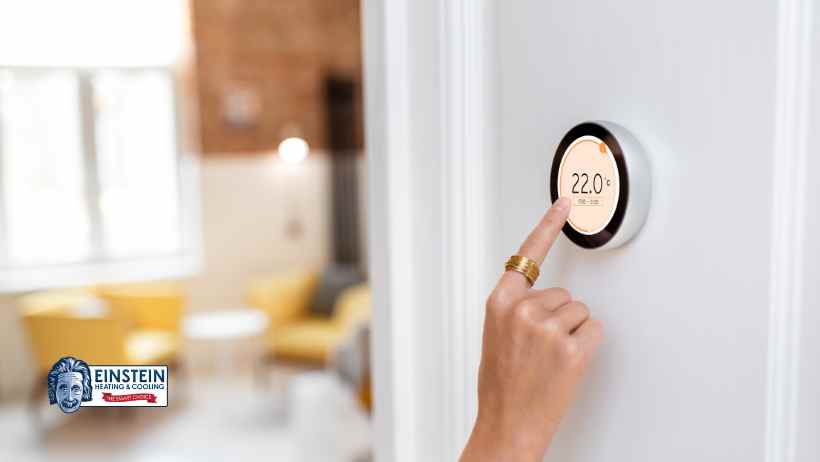Smart thermostats are becoming increasingly popular among homeowners in Phoenix. They offer a range of benefits, such as energy savings, convenience, and improved comfort. However, they also have their drawbacks. In this blog post, we’ll take a closer look at the pros and cons of installing a smart thermostat in your new HVAC in Phoenix, Arizona.
Pros:
1. Energy Savings
One of the most significant advantages of a smart thermostat is its ability to save energy. Smart thermostats can learn your schedule and adjust the temperature accordingly, ensuring that your home is at the optimal temperature only when you need it to be. This can lead to significant energy savings and lower utility bills.
Smart thermostats are designed to optimize energy usage and reduce waste, resulting in energy savings and lower utility bills. Here are some key features and benefits of smart thermostats that contribute to these energy savings:
- Learning and adaptive technology: Smart thermostats can learn your daily routine and preferences over time. They analyze patterns in your heating and cooling behavior, occupancy, and external factors like weather conditions. Based on this data, they can automatically adjust the temperature to optimize comfort while minimizing energy consumption. This adaptability ensures that your home is efficiently heated or cooled only when necessary.
- Remote access and control: Most smart thermostats come with mobile apps or web interfaces that allow you to control and monitor your home’s temperature remotely. This feature enables you to adjust the temperature even when you’re away from home. For example, if you’re returning home earlier than expected, you can remotely raise the temperature to ensure comfort upon arrival. By avoiding unnecessary heating or cooling, you can save energy.
- Geofencing and occupancy sensing: Some smart thermostats incorporate geofencing technology, which uses the location of your smartphone to determine whether you’re at home or away. When you leave the predefined geofence, the thermostat can automatically adjust to an energy-saving temperature setting. When you approach your home, it can start adjusting the temperature back to a comfortable level. Occupancy sensing features can also detect if a room is unoccupied and adjust the temperature accordingly, avoiding unnecessary heating or cooling.
- Energy usage insights and reports: Smart thermostats often provide detailed energy usage reports and insights, giving you visibility into your heating and cooling patterns. You can identify trends, track energy consumption, and make informed decisions about energy-saving adjustments. By understanding your usage habits, you can optimize your thermostat settings and further reduce energy waste.
- Integration with smart home systems: Smart thermostats can integrate with other smart home devices, such as motion sensors, window sensors, or door sensors. This integration allows them to coordinate with these devices to optimize energy usage. For example, if a window is opened, the thermostat can temporarily adjust the temperature to conserve energy until the window is closed.
By leveraging these features and benefits, smart thermostats help minimize energy waste, reduce heating and cooling costs, and promote a more sustainable and efficient home environment.
2. Remote Access
Smart thermostats are a great HVAC innovation can be controlled remotely through your smartphone, tablet, or computer. This means that you can adjust your home’s temperature even when you’re not there. For example, you can turn off your air conditioning when you leave for work and turn it back on before you arrive home, ensuring that your home is at a comfortable temperature when you get there.
The remote access feature of smart thermostats allows you to control and monitor your home’s temperature settings from anywhere using your smartphone, tablet, computer, or even voice assistants. Here are some key points about remote access and its benefits:
- Convenience: Remote access gives you the convenience of controlling your thermostat settings without being physically present at home. Whether you’re at work, on vacation, or simply in another room, you can easily adjust the temperature to your liking with just a few taps or voice commands. It eliminates the need to manually operate the thermostat or rely on timers.
- Energy efficiency: With remote access, you can actively manage your energy usage by adjusting the temperature based on your schedule. For example, you can turn off the heating or cooling when you leave for the day and remotely activate it before you return, ensuring a comfortable environment while minimizing energy waste. This can lead to significant energy savings and lower utility bills.
- Adaptive scheduling: Many smart thermostats have adaptive scheduling features that learn your preferences and daily routines. By accessing your thermostat remotely, you can make real-time adjustments to the schedule if your plans change. For instance, if you decide to come home early or stay out late, you can modify the temperature settings accordingly, ensuring comfort and efficiency.
- Vacation mode: When you’re away on vacation or an extended trip, remote access allows you to put your thermostat into vacation mode. This mode adjusts the temperature to an energy-saving level while you’re away, helping to conserve energy and reduce costs. You can easily deactivate vacation mode and set the temperature back to normal before returning home.
- Monitoring and alerts: Remote access also enables you to monitor your home’s temperature and receive alerts or notifications if there are any significant changes or issues. For instance, if the temperature falls below a certain threshold during winter, you can be alerted to potential freezing pipe risks and take appropriate action remotely, such as adjusting the temperature or contacting someone to resolve the issue.
It’s important to note that remote access requires an internet connection and the compatible mobile app or web interface provided by the smart thermostat manufacturer. By leveraging remote access capabilities, you gain greater control over your home’s temperature, enhance energy efficiency, and improve overall comfort and convenience.
3. Easy to Use
Smart thermostats are user-friendly and easy to use. They often come with intuitive interfaces and can be set up quickly and easily. Once installed, you can control your thermostat using voice commands or an app on your smartphone.
User-friendliness and ease of use are key features of smart thermostats. Here’s why they are considered easy to use:
- Intuitive interfaces: Smart thermostats typically have user-friendly interfaces with clear and straightforward menus and controls. They are designed to be easy to navigate, allowing you to adjust temperature settings, set schedules, and access additional features without any confusion. Many smart thermostats also have touchscreen displays that make it convenient to interact with the device directly.
- Quick and easy installation: Smart thermostats are designed for easy installation, often with detailed instructions and compatibility guides. Many models are compatible with the existing wiring in your home, making the installation process relatively simple. In some cases, professional installation may be recommended, but the majority of smart thermostats are designed for do-it-yourself installation.
- Seamless integration with apps and voice assistants: Most smart thermostats come with dedicated mobile apps that can be easily downloaded and installed on your smartphone or tablet. These apps provide a user-friendly interface that allows you to control and monitor your thermostat remotely. Additionally, smart thermostats often integrate with popular voice assistants like Amazon Alexa, Google Assistant, or Apple HomeKit. This integration enables you to control your thermostat using voice commands, making it even more convenient and easy to operate.

- Guided setup and programming: Smart thermostats often have guided setup processes that walk you through the initial configuration. They may ask questions about your preferred temperature settings, occupancy patterns, and other factors to personalize the thermostat’s behavior. Once set up, the thermostat can learn from your inputs and adjust its programming accordingly, simplifying the process of creating and modifying schedules. Make sure to set up a maintenance schedule to keep your HVAC running smoothly.
- Automatic temperature adjustments: Many smart thermostats incorporate advanced features like learning algorithms and occupancy sensors. These features enable the thermostat to automatically adjust the temperature based on your behavior and occupancy patterns, reducing the need for manual intervention. This automation makes it effortless for users to maintain a comfortable environment without constantly having to make adjustments.
Overall, smart thermostats are designed to provide a seamless and user-friendly experience. Their intuitive interfaces, easy installation, mobile app integration, voice control options, and automation capabilities make them accessible and convenient for users of all technical backgrounds.
4. Improved Comfort
Smart thermostats can help improve the comfort of your home by maintaining a consistent temperature throughout the day. They can also adjust the temperature based on your preferences and the time of day, ensuring that your home is always at a comfortable temperature. If you wish to prepare your HVAC units for the summer and winter, upgrading to a smart thermostat is one of the best choices.
Smart thermostats are designed to enhance comfort in your home by providing precise temperature control and customization. Here’s how they contribute to improved comfort:
- Consistent temperature control: Smart thermostats allow you to set and maintain a consistent temperature throughout the day. They can adjust the heating or cooling system to ensure that your home remains at your desired temperature, eliminating temperature fluctuations and creating a more comfortable environment.
- Customizable settings: Smart thermostats offer a range of customizable settings to suit your preferences. You can program temperature schedules based on your daily routine, ensuring that your home is comfortably heated or cooled when you need it. For example, you can set the thermostat to warm up the living room in the morning before you wake up or cool down the bedroom before you go to sleep.
- Personalized comfort preferences: Many smart thermostats come with features that allow you to personalize your comfort preferences. You can set specific temperature targets for different zones or rooms in your home, ensuring that each area is maintained at the optimal comfort level for its occupants. Some thermostats even have occupancy sensors that adjust the temperature based on room occupancy, providing comfort where and when it’s needed.
- Adaptive learning: Smart thermostats often incorporate adaptive learning algorithms that can learn your temperature preferences over time. They analyze your behavior patterns, occupancy, and external factors like weather conditions to automatically adjust the temperature. This adaptive learning helps create a more comfortable environment without the need for manual adjustments.
- Remote access and control: The remote access feature of smart thermostats allows you to control the temperature even when you’re not at home. You can adjust the temperature on your way back from work, ensuring that your home is at a comfortable level when you arrive. This capability enhances comfort and eliminates the need to wait for your home to reach a desirable temperature.
By combining precise temperature control, customizable settings, personalized comfort preferences, adaptive learning, and remote access, smart thermostats contribute to an improved and tailored comfort experience in your home.
Cons:
1. Cost
Smart thermostats can be expensive compared to traditional thermostats. However, many homeowners find that the energy savings and convenience of a smart thermostat make up for the initial cost over time.
The cost of smart thermostats can vary depending on several factors, including the brand, features, and model you choose. Generally, smart thermostats are priced higher than traditional thermostats due to their advanced technology and capabilities. However, it’s important to note that the prices of smart thermostats have become more competitive over time as the market has expanded.
Entry-level smart thermostats can range from around $100 to $150, while more advanced models with additional features can cost between $200 and $300. High-end smart thermostats with advanced sensors, learning algorithms, and integration with smart home systems may cost even more.
While the upfront cost of a smart thermostat may be higher compared to a traditional thermostat, it’s important to consider the potential long-term savings in energy costs. The energy-efficient features and capabilities of smart thermostats can help reduce energy waste and lower your heating and cooling expenses over time.
Additionally, some utility companies offer rebates or incentives for installing energy-efficient devices like smart thermostats. These incentives can help offset the initial cost and make the transition to a smart thermostat more affordable.
Ultimately, the decision to invest in a smart thermostat will depend on your budget, energy-saving HVAC goals, and preferences for convenience and automation. It’s recommended to research and compare different models to find one that suits your needs and offers the best value for your investment.
2. Compatibility
Not all HVAC systems are compatible with smart thermostats. Before purchasing a smart thermostat, it’s essential to ensure that it’s compatible with your HVAC system. If your HVAC system is not compatible, you may need to purchase a new system, which can be expensive.
Compatibility between smart thermostats and HVAC systems is an important consideration before making a purchase. Here are some key points to keep in mind:
- HVAC system compatibility: Smart thermostats are designed to work with a wide range of heating, ventilation, and air conditioning (HVAC) systems. However, it’s crucial to check the compatibility of the smart thermostat with your specific HVAC system before making a purchase. Common types of HVAC systems include forced air systems, heat pumps, boilers, and radiant heating systems. Each system has its own wiring and control requirements, and not all smart thermostats support every type.
- Wiring compatibility: The wiring of your existing thermostat and HVAC system should align with the wiring requirements of the smart thermostat you intend to purchase. Smart thermostats typically require a “C” wire (or common wire) for continuous power supply, although some models offer alternative power options. It’s important to check if your HVAC system has a “C” wire or if the smart thermostat is compatible with your specific wiring configuration. If your HVAC system doesn’t have a “C” wire and the smart thermostat requires one, you may need to install a power adapter or have a professional installer run a new wire, which could incur additional costs.
- Additional features and accessories: Some smart thermostats offer advanced features or require additional accessories that may not be compatible with all HVAC systems. For example, compatibility with multi-stage heating or cooling systems, dual fuel systems, or humidifier/dehumidifier control may vary depending on the smart thermostat model. It’s important to review the specifications and compatibility information provided by the smart thermostat manufacturer to ensure it meets your specific requirements.
- Professional consultation: If you’re unsure about the compatibility of a smart thermostat with your HVAC system, it’s recommended to consult with a professional HVAC technician or an expert in smart home installations. They can assess your HVAC system, review the compatibility of different smart thermostat options, and provide guidance on the most suitable choice for your specific setup.
It’s crucial to thoroughly research and understand the compatibility requirements of smart thermostats before purchasing one. Ensuring compatibility will help avoid compatibility issues and the need for costly system upgrades or modifications.
3. Dependence on Wi-Fi
Smart thermostats require a Wi-Fi connection to function properly. If your Wi-Fi connection is unreliable or goes out, your thermostat may not work correctly. Additionally, if there is a power outage, your smart thermostat may lose its programming and require reprogramming.
Smart thermostats rely on a stable Wi-Fi connection to provide their full range of features and functionality. Here are some important points to consider regarding the dependence on Wi-Fi:
- Functionality and remote access: Wi-Fi connectivity allows you to control and monitor your smart thermostat remotely through a mobile app or web interface. You can adjust temperature settings, set schedules, and receive updates or alerts. Without a Wi-Fi connection, you would lose these remote access capabilities and would need to manually operate the thermostat at the device itself.
- Real-time updates and data synchronization: Smart thermostats use Wi-Fi to communicate with the manufacturer’s servers or cloud platforms, enabling real-time updates, data synchronization, and access to weather information. This connectivity ensures accurate temperature control and enables features like adaptive learning or geofencing. Interruptions in Wi-Fi connectivity can disrupt these functions and prevent the thermostat from operating optimally.
- Power outage and programming: In the event of a power outage, smart thermostats may lose their programming and temporarily revert to default settings. This means that any customized schedules or preferences you have set may need to be reprogrammed once the power is restored. However, some smart thermostats have internal backup batteries that can help maintain programming and settings during short power outages.
- Offline functionality: While smart thermostats heavily rely on Wi-Fi, many models have limited offline functionality. They can still maintain basic temperature control and operate according to pre-set schedules even without an internet connection. However, you would lose the ability to remotely control the thermostat or access advanced features until the Wi-Fi connection is restored.
To mitigate the impact of Wi-Fi outages or unreliable connections, it’s advisable to ensure a stable and reliable Wi-Fi network in your home. This includes placing your Wi-Fi router in an optimal location, ensuring proper signal strength, and addressing any network issues promptly. Additionally, consider choosing a smart thermostat that has local controls or buttons that allow you to make adjustments directly on the device when necessary.
It’s important to note that while Wi-Fi dependence is a consideration, the core functionality of temperature control and scheduling can still be maintained without an active Wi-Fi connection.
4. Privacy Concerns
Smart thermostats collect data about your usage patterns, which can raise privacy concerns for some homeowners. However, most smart thermostat manufacturers have privacy policies in place to ensure that your data is secure.
Privacy concerns can arise with the use of smart thermostats. Here are some important points to consider regarding privacy:
- Data collection: Smart thermostats collect data about your usage patterns, including temperature settings, occupancy, and potentially even location data if geofencing features are enabled. This data is used to provide personalized temperature control, adaptive learning, and energy-saving features. It’s important to review the privacy policy of the smart thermostat manufacturer to understand what data is collected and how it is used.
- Data security: Smart thermostat manufacturers typically have privacy policies and security measures in place to protect your data. They may use encryption techniques and secure cloud storage to ensure that your information is safeguarded. It’s advisable to choose reputable brands and manufacturers with a track record of prioritizing data security and privacy.
- Data sharing and third parties: Some smart thermostat manufacturers may share data with third-party partners or service providers for purposes such as system improvement or targeted advertising. It’s essential to review the privacy policy to understand how and with whom your data may be shared. Look for opt-out options if you prefer not to have your data shared with third parties.
- User control and transparency: Many smart thermostat models offer users control over their data and settings. You may have the option to disable certain features, adjust data collection settings, or delete your data. Transparent communication from the manufacturer about their data practices is important so that you can make informed decisions about the use of your data.
- Offline functionality: Some smart thermostats offer offline functionality, which means they can operate without an internet connection. This can provide an additional layer of privacy since data may not be transmitted to external servers during offline periods.
To address privacy concerns, it’s recommended to carefully review the privacy policy and terms of service of the smart thermostat manufacturer before making a purchase. Consider factors such as data collection, data security measures, data sharing practices, and user control options. Additionally, stay informed about software updates and security patches provided by the manufacturer to ensure your smart thermostat remains up to date with the latest privacy and security enhancements.
Overall, while privacy concerns are valid, many smart thermostat manufacturers prioritize data security and provide privacy policies that outline how they handle user data. It’s essential to balance the benefits of the features offered by smart thermostats with your comfort level regarding data collection and usage.
In conclusion, smart thermostats offer many benefits to Phoenix homeowners, including energy savings, convenience, and improved comfort. However, they also have their drawbacks, such as cost, compatibility issues, dependence on Wi-Fi, and privacy concerns. Before purchasing a smart thermostat, it’s essential to consider both the pros and cons and determine whether it’s the right choice for your home. It’s also important that you know how to fix a thermostat when needed, especially before calling a technician.
If you decide to install a smart thermostat, be sure to choose a reputable manufacturer and work with a professional HVAC technician to ensure that your thermostat is installed correctly and functions properly. With the right installation and maintenance, a smart thermostat can provide you with years of energy savings and comfort in your Phoenix home.








